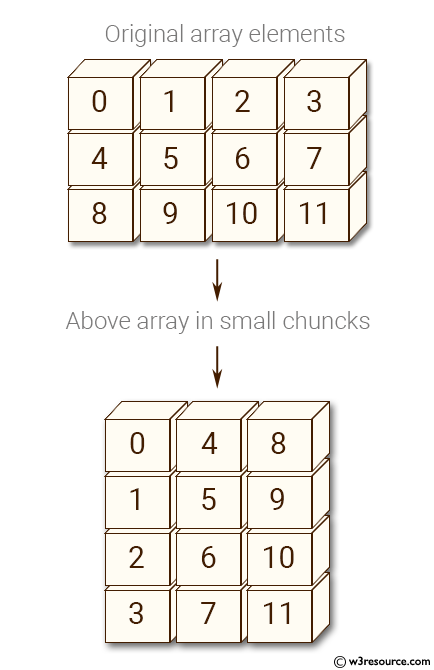NumPy: Create an array of (3, 4) shape and convert the array elements in smaller chunks
Chunkify (3,4) Array Elements
Write a NumPy program to create an array of (3, 4) shapes and convert the array elements into smaller chunks.
Pictorial Presentation:

Sample Solution:
Python Code:
# Importing the NumPy library and aliasing it as 'np'
import numpy as np
# Creating a 1-dimensional array 'x' with values from 0 to 11 and reshaping it into a 3x4 array
x = np.arange(12).reshape(3, 4)
# Printing a message indicating the original array elements will be shown
print("Original array elements:")
# Printing the original array 'x' with its elements
print(x)
# Printing a message indicating the array will be displayed in small chunks
print("Above array in small chunks:")
# Using np.nditer to iterate through the array 'x' in Fortran order with external loop
# Iterating through 'x' in a way that external_loop flag generates chunks of elements in the Fortran order
for a in np.nditer(x, flags=['external_loop'], order='F'):
print(a) # Printing each chunk
Sample Output:
Original array elements: [[ 0 1 2 3] [ 4 5 6 7] [ 8 9 10 11]] Above array in small chuncks: [0 4 8] [1 5 9] [ 2 6 10] [ 3 7 11]
Explanation:
x= np.arange(12).reshape(3, 4): Create an array x with values from 0 to 11, and reshape it into a 3x4 array.
for a in np.nditer(x, flags=['external_loop'], order='F'):: Use np.nditer to create an iterator for array x. Set the flags parameter to include 'external_loop', which allows for iterating over larger chunks of the array at once, based on memory layout. Set the order parameter to 'F' to iterate over the array in Fortran/column-major order (i.e., column by column).
Finally print(a) prints the current chunk in the iteration.
For more Practice: Solve these Related Problems:
- Write a NumPy program to split a (3,4) array into column-wise chunks using np.hsplit and validate each chunk.
- Create a function that divides a 2D array into smaller sub-arrays (chunks) and verifies the dimensions of each.
- Test chunking of a 2D array by splitting rows into multiple segments and reassembling them later.
- Utilize slicing to manually divide a (3,4) array into column chunks and compare with the np.hsplit output.
Go to:
PREV : Apply Cube Function to All Elements
NEXT : Create Record Array from Flat Lists
Python-Numpy Code Editor:
Have another way to solve this solution? Contribute your code (and comments) through Disqus.What is the difficulty level of this exercise?
Test your Programming skills with w3resource's quiz.
